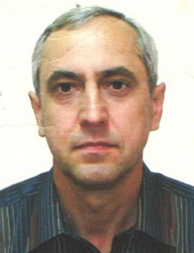Boyko Sergey

Date of birth: 06.03.1956
Education, education organization name, city, specialization.
1) State university in Kharkov (1978), radio physics and electronics, Radio physicist.
2) PhD of physicomathematical science (1989)
Sergey N. Boyko has been working in the patent research and patent licensing since 2004.
Since 1991 had been taking part in science-research work in the area of navigation, in particular antenna and feeder devices, laboratory centers for measuring antennas and antenna arrays, patent research in principally new UHF subjects.
At the present time manages the science-manufacturing complex, which works at antenna module and small size antenna elements, based on metamaterials, researching and production for applications in navigation apparatus GLONASS.
During the work makes a personal contribution to the protection of the results of the intellectual work and technologies on priority directions of development of space systems and complexes of new generation.
He is the author of 24 science works (articles and reports) and 13 inventions, in particular used in the space technique.
Reports:
Nowadays the standard antenna module design approaches and methods are formed in world practice. In report just our methods and solutions, which differ from the conventional ones, are presented.
Our company has suggested an original engineering conception of the navigation antenna module design, involving the idea that a dielectric substrate of the antenna element is made of a ceramic in the form of a turned cup provided with the patch on its top and metalized cavity, in which all active elements are placed. The cup-shaped antenna element has additional advantages against the patch antenna of a traditional form: it has a wider matching band, higher radiation efficiency, a wider radiation pattern, and a wider (up to 1.5 times) zenith angle range, in which circular field polarization persists. These advantages give a prospect of the total navigation antenna module miniaturization.
Metamaterial-made antenna element in an all-ceramic type antenna module is also presented. Metamaterial, used in the antenna element, improves such parameters as bandwidth, gain, selectivity, radiation efficiency and allows obtaining a circular field polarization even at low elevation angles, which only quadrifilar antenna has. The antenna module has a flat and compact planar configuration, minimum weight and due to this fact, it can be implemented into any compact on-board or even on-body devices.
To work with all operating GNSS systems (in the extended bandwidth) we propose an antenna element, which has two planar axial elements placed on the common substrate. Two elements have distributed mutual coupling, what allows achieving antenna element matching with 50-Ohm feeding and keeping a radiation pattern invariable in the L1 GLONASS/GPS/GALILEO bands.
For designing the multi frequency microstrip antennas the method when antennas for higher frequencies are placed above antennas for lower frequencies is usually used. Such antennas were named as stacked microstrip antennas. The main deficiency of multi frequency stacked microstrip antennas is a high mutual influence of the antenna elements, resulting a radiation pattern distortion and low mutual isolation of the antenna inputs. We have suggested a multi frequency stacked antenna design method with opposite feeding of the antenna elements, which provides the antenna element isolation of more than 25 dB and identical radiation patterns in the L1 and L2 bands.
Under the special GNSS antenna application, it is very important not to receive multipath signals, which increase an error at determining co-ordinates. But all multipath mitigating ground planes have a common deficiency: they are making the antenna radiation patterns narrower and spoil the antenna element phase center stability. We propose to use for multipath mitigating a special type of the EBG-metamaterial and, as well, a special method of multipath mitigating ground plane mounting, which has no such a deficiency.
Thus, innovative navigation antenna module constructing approaches, considered in the paper, allow with the use of their combinations creating devises, which have almost any parameter combinations and operating characteristics for implementing in to various GNSS receiving equipment.





